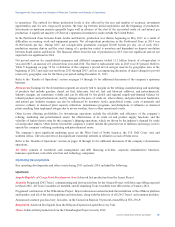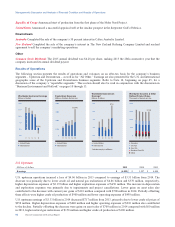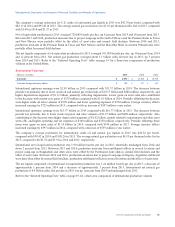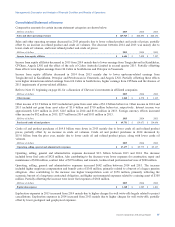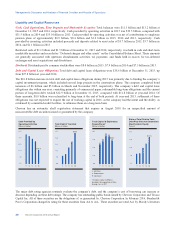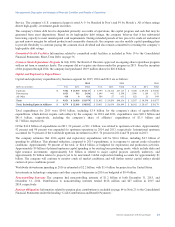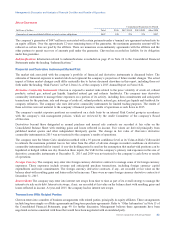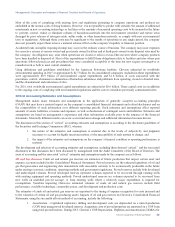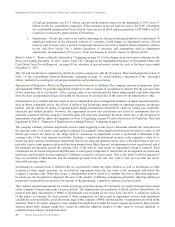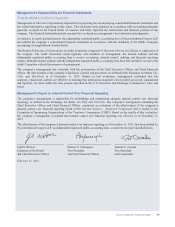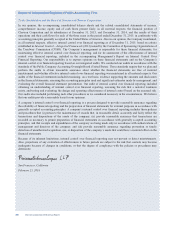Chevron 2015 Annual Report Download - page 25
Download and view the complete annual report
Please find page 25 of the 2015 Chevron annual report below. You can navigate through the pages in the report by either clicking on the pages listed below, or by using the keyword search tool below to find specific information within the annual report.
Management’s Discussion and Analysis of Financial Condition and Results of Operations
Direct Guarantees
Commitment Expiration by Period
Millions of dollars Total 2016 2017-2018 2019-2020 After 2020
Guarantee of nonconsolidated affiliate or joint-venture obligations $447 $38 $76 $76 $257
The company’s guarantee of $447 million is associated with certain payments under a terminal use agreement entered into by
an equity affiliate. Over the approximate 12-year remaining term of the guarantee, the maximum guarantee amount will be
reduced as certain fees are paid by the affiliate. There are numerous cross-indemnity agreements with the affiliate and the
other partners to permit recovery of amounts paid under the guarantee. Chevron has recorded no liability for its obligation
under this guarantee.
Indemnifications Information related to indemnifications is included on page 65 in Note 24 to the Consolidated Financial
Statements under the heading “Indemnifications.”
Financial and Derivative Instrument Market Risk
The market risk associated with the company’s portfolio of financial and derivative instruments is discussed below. The
estimates of financial exposure to market risk do not represent the company’s projection of future market changes. The actual
impact of future market changes could differ materially due to factors discussed elsewhere in this report, including those set
forth under the heading “Risk Factors” in Part I, Item 1A, of the company’s 2015 Annual Report on Form 10-K.
Derivative Commodity Instruments Chevron is exposed to market risks related to the price volatility of crude oil, refined
products, natural gas, natural gas liquids, liquefied natural gas and refinery feedstocks. The company uses derivative
commodity instruments to manage these exposures on a portion of its activity, including firm commitments and anticipated
transactions for the purchase, sale and storage of crude oil, refined products, natural gas, natural gas liquids and feedstock for
company refineries. The company also uses derivative commodity instruments for limited trading purposes. The results of
these activities were not material to the company’s financial position, results of operations or cash flows in 2015.
The company’s market exposure positions are monitored on a daily basis by an internal Risk Control group in accordance
with the company’s risk management policies, which are reviewed by the Audit Committee of the company’s Board
of Directors.
Derivatives beyond those designated as normal purchase and normal sale contracts are recorded at fair value on the
Consolidated Balance Sheet with resulting gains and losses reflected in income. Fair values are derived principally from
published market quotes and other independent third-party quotes. The change in fair value of Chevron’s derivative
commodity instruments in 2015 was not material to the company’s results of operations.
The company uses the Monte Carlo simulation method with a 95 percent confidence level as its Value-at-Risk (VaR) model
to estimate the maximum potential loss in fair value from the effect of adverse changes in market conditions on derivative
commodity instruments held or issued. A one-day holding period is used on the assumption that market-risk positions can be
liquidated or hedged within one day. Based on these inputs, the VaR for the company’s primary risk exposures in the area of
derivative commodity instruments at December 31, 2015 and 2014 was not material to the company’s cash flows or results
of operations.
Foreign Currency The company may enter into foreign currency derivative contracts to manage some of its foreign currency
exposures. These exposures include revenue and anticipated purchase transactions, including foreign currency capital
expenditures and lease commitments. The foreign currency derivative contracts, if any, are recorded at fair value on the
balance sheet with resulting gains and losses reflected in income. There were no open foreign currency derivative contracts at
December 31, 2015.
Interest Rates The company may enter into interest rate swaps from time to time as part of its overall strategy to manage the
interest rate risk on its debt. Interest rate swaps, if any, are recorded at fair value on the balance sheet with resulting gains and
losses reflected in income. At year-end 2015, the company had no interest rate swaps.
Transactions With Related Parties
Chevron enters into a number of business arrangements with related parties, principally its equity affiliates. These arrangements
include long-term supply or offtake agreements and long-term purchase agreements. Refer to “Other Information” in Note 15 of
the Consolidated Financial Statements, page 49, for further discussion. Management believes these agreements have been
negotiated on terms consistent with those that would have been negotiated with an unrelated party.
Chevron Corporation 2015 Annual Report 23


